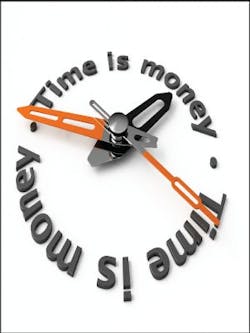The way January McPhail sees it, the one common trend in all repair shops is that they are all different. No two shops are alike, she says, and that’s because they are all made up of different people—people who are motivated in different ways.
“There’s not an employee anywhere in any business, anywhere in the world, that goes to work just for a paycheck,” she says. “A good employee wants more than that. They want the satisfaction of knowing that they did a good job and that someone recognizes that. They want to know that they are appreciated.”
McPhail, who co-owns Marshall Motors in Dallas, Texas, with her brother Thom Marshall, says one of the best ways to accommodate this common employee desire is through rewards.
Since 1998, McPhail’s shop has utilized a low-base, high-production bonus pay system, in which her technicians are progressively rewarded for their efficiency in the shop.
“And it works,” McPhail says. “All of our techs are highly skilled and good at what they do. With this type of system, they stay motivated, and their productivity is nearly always above 100 percent.”
Industry consultant Bob Spitz of Management Success! says that, while a shop needs to find the best approach to fit its specific needs, switching to a performance-based pay scale is a smart way to increase your shop’s efficiency and improve the bottom line.
And it’s relatively simple to set up and operate.
An Introduction to Performance-Based Pay
A mechanical repair facility is a production environment, Spitz says, and shop owners can’t afford to simply pay employees for their time.
“Pay has to be about their production,” he says.
Spitz cringes at the thought of salaried technicians, and, he says, a flat-rate pay system is still too limited in encouraging high production levels. That’s why Spitz is a proponent of a low-base, high-production bonus system.
HOW IT LOOKS—TWO OPTIONS
There are two basic ways to make the low-base, high-production bonus system work. One is to award a lump-sum bonus once a threshold for hours is hit; the other is to increase hourly wage when a tech reaches a certain threshold. Here are hypothetical scenarios Spitz and McPhail gave to demonstrate. (The exact numbers do not reflect McPhail’s payment system.)
Lump-sum bonus system
Base pay » $17 per billable hour.
Bonuses (per week):
<40.00 billable hours » No bonus
40.01-40.99 billable hours » $50
50.00-50.99 billable hours » $100
60+ billable hours » $200
Hourly-wage increase
Base pay » $17 per billable hour.
Wage scale:
<40.00 billable hours » $17 (per billable hour for all hours worked)
40.01-40.99 billable hours » $19
50.00-50.99 billable hours » $23
60+ billable hours » $25
Similar to flat-rate, this performance-based model is focused on billable hours. And a shop starts with giving the tech a relatively low base pay per billable hour. Once the employee reaches a certain threshold of billable hours in a week, they receive a bonus—either in a lump sum or in an increase in hourly wage.
This is how McPhail pays her techs. Each tech is given that initial wage per billable hour (based on experience level, training, certification, etc.), and once they exceed 40 hours in a week, their wage increases on all hours they worked that week. The same happens when they reach 50 hours, 60 hours and so on.
“This gives them the incentive to do more work and make more money,” McPhail says. “And, if they do more work, the shop makes more money.”
How to Set It Up
Any major change to a business cannot—and should not—happen overnight, Spitz says. Shop owners need to carefully plan a shift in payment strategy to make sure they make changes that will help the company succeed in all facets.
There are a number of specific steps he suggests you take when implementing a performance-based pay system:
• Understand your business. Before making a change, Spitz says to really analyze your current system: Where are its pitfalls? Why is a change needed? What is your current plan lacking? Also, understanding the specific numbers—revenue, car count, billable hours, etc.—your shop needs to hit to turn a profit helps you figure out a new pay system you can afford.
• Run scenarios. Suppose you have a tech that bills 35 hours a week, and you put in an aggressive plan, and he suddenly bills 60. Can you afford that jump? Spitz says to consider all scenarios when deciding on a plan and wages. McPhail, for instance, bases her budget on the highest possible wages her techs can earn.
• Forget about your labor rate. It’s an easy mistake, Spitz says, to let labor rate have an effect on a tech’s wages. It’s a costly one, too. “If you raise your labor rate, then they automatically get a raise,” Spitz says.
• Find a win-win-win situation. A performance-based payment system not only affects technicians, but it also has an immense impact on the business and the way it helps customers. All three areas need to be accounted for: The tech needs to feel appreciated; the shop needs to be successful; and the customer needs to be taken care of with quality service.
• Compare to business benchmarks. Spitz says that only 20 percent of sales can go into production and labor costs for a shop to stay profitable. And employee costs are a loaded item; they come with taxes, insurance, benefits, etc. A plan still needs to keep P&L costs bellow that 20 percent mark, keeping in mind all costs to have an employee on staff.
• Make sure it’s legal. Labor laws differ from state to state, and Spitz suggests that, even if you feel you have a good handle on all the rules, to have a lawyer review the plan.
Making it Work
A high-production bonus system can create hang-ups, but it’s an owner’s job to eliminate those, McPhail says. There can be some questions from techs when these types of plans are put into place, often about how work is assigned.
McPhail keeps a large board on a wall in the shop that lists each of her four techs and their specific assigned jobs. It shows jobs checked in, jobs checked out and number of hours they billed for that day. So, each employee can see what the other is working on, and each can see, in real time, how productive he or she is in comparison to coworkers.
“You have to keep things fair, and they have to feel that it’s fair,” McPhail says. “Having it for everyone to see is the best way we’ve found of doing that.”
And, she says, it helps motivate them to keep up with each other.
With fast work, though, can come fast mistakes. That’s why McPhail implemented a quality control process, in which the service advisor runs through a checklist on every car before a customer picks it up. This covers everything from the details of the paid job to making sure there are no finger smudges on the exterior.
McPhail says it’s pretty simple to see if the payment model works: just look at productivity levels and your bottom line. She says her shop saw quick improvements in efficiency when it went from a standard flat-rate system to this base-plus-bonus model.
“This is a model that has worked great for us, and you have to find what works best for you,” she says. “Every shop is different, and the main difference is the people. Having a system that rewards employees for their level of work only helps your business.”
About the Author

Bryce Evans
Bryce Evans is the vice president of content at 10 Missions Media, overseeing an award-winning team that produces FenderBender, Ratchet+Wrench and NOLN.
